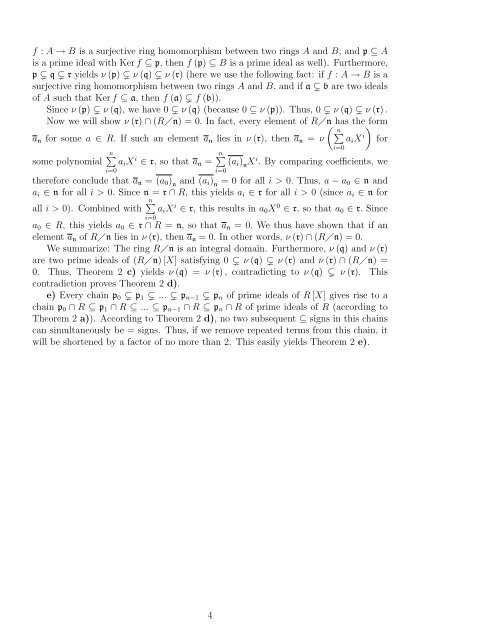Seidenberg's theorems about Krull dimension of polynomial rings ...
Seidenberg's theorems about Krull dimension of polynomial rings ...
Seidenberg's theorems about Krull dimension of polynomial rings ...
Create successful ePaper yourself
Turn your PDF publications into a flip-book with our unique Google optimized e-Paper software.
f : A → B is a surjective ring homomorphism between two <strong>rings</strong> A and B, and p ⊆ A<br />
is a prime ideal with Ker f ⊆ p, then f (p) ⊆ B is a prime ideal as well). Furthermore,<br />
p q r yields ν (p) ν (q) ν (r) (here we use the following fact: if f : A → B is a<br />
surjective ring homomorphism between two <strong>rings</strong> A and B, and if a b are two ideals<br />
<strong>of</strong> A such that Ker f ⊆ a, then f (a) f (b)).<br />
Since ν (p) ν (q), we have 0 ν (q) (because 0 ⊆ ν (p)). Thus, 0 ν (q) ν (r) .<br />
Now we will show ν (r) ∩ (Rn) = 0. In fact, every element <strong>of</strong> Rn ( has the form<br />
n<br />
)<br />
∑<br />
a n for some a ∈ R. If such an element a n lies in ν (r), then a n = ν a i X i for<br />
i=0<br />
n∑<br />
∑<br />
some <strong>polynomial</strong> a i X i ∈ r, so that a n = n (a i ) n<br />
X i . By comparing coefficients, we<br />
i=0<br />
therefore conclude that a n = (a 0 ) n<br />
and (a i ) n<br />
= 0 for all i > 0. Thus, a − a 0 ∈ n and<br />
a i ∈ n for all i > 0. Since n = r ∩ R, this yields a i ∈ r for all i > 0 (since a i ∈ n for<br />
∑<br />
all i > 0). Combined with n a i X i ∈ r, this results in a 0 X 0 ∈ r, so that a 0 ∈ r. Since<br />
i=0<br />
a 0 ∈ R, this yields a 0 ∈ r ∩ R = n, so that a n = 0. We thus have shown that if an<br />
element a n <strong>of</strong> Rn lies in ν (r), then a n = 0. In other words, ν (r) ∩ (Rn) = 0.<br />
We summarize: The ring Rn is an integral domain. Furthermore, ν (q) and ν (r)<br />
are two prime ideals <strong>of</strong> (Rn) [X] satisfying 0 ν (q) ν (r) and ν (r) ∩ (Rn) =<br />
0. Thus, Theorem 2 c) yields ν (q) = ν (r) , contradicting to ν (q) ν (r). This<br />
contradiction proves Theorem 2 d).<br />
e) Every chain p 0 p 1 ... p n−1 p n <strong>of</strong> prime ideals <strong>of</strong> R [X] gives rise to a<br />
chain p 0 ∩ R ⊆ p 1 ∩ R ⊆ ... ⊆ p n−1 ∩ R ⊆ p n ∩ R <strong>of</strong> prime ideals <strong>of</strong> R (according to<br />
Theorem 2 a)). According to Theorem 2 d), no two subsequent ⊆ signs in this chains<br />
can simultaneously be = signs. Thus, if we remove repeated terms from this chain, it<br />
will be shortened by a factor <strong>of</strong> no more than 2. This easily yields Theorem 2 e).<br />
i=0<br />
4
















